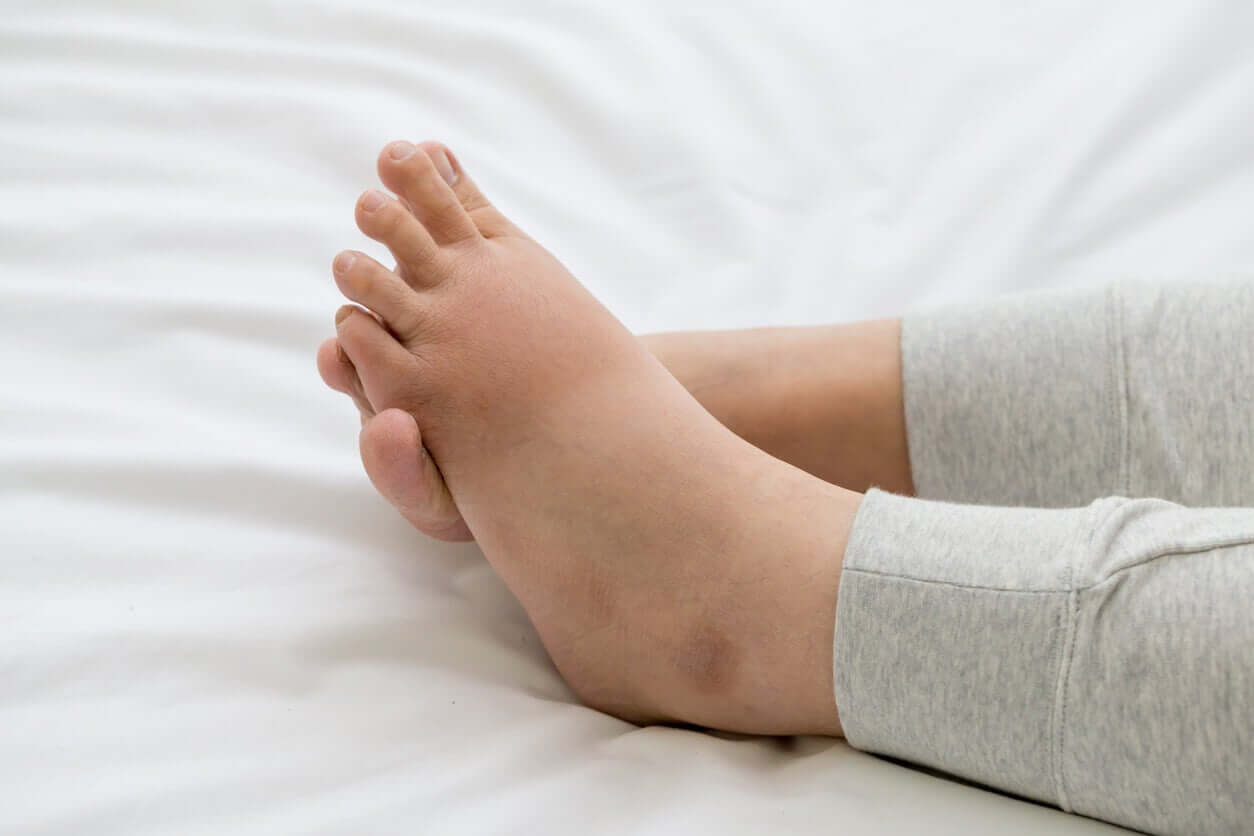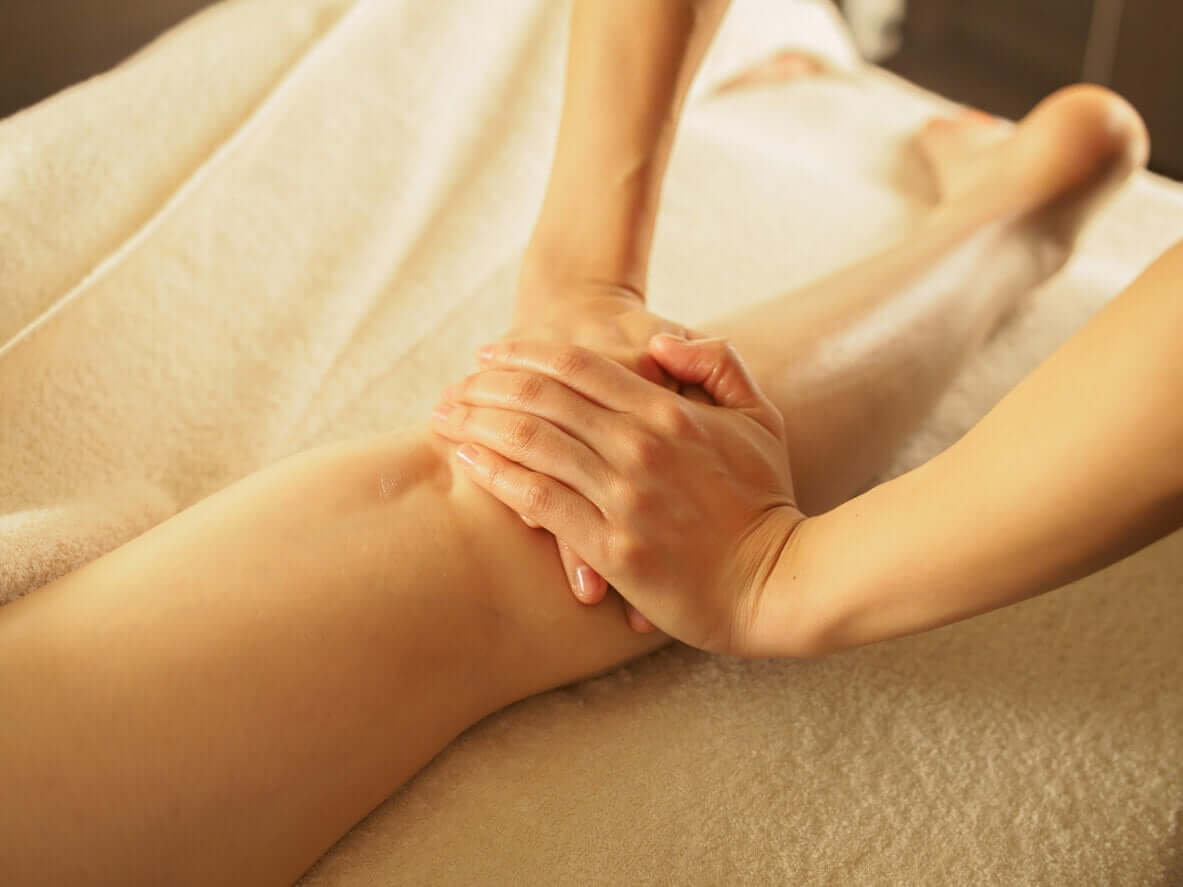Swollen Feet After Childbirth: What You Need to Know

Many women think that after the baby’s born, everything returns to normal as if by magic. However, the maternal body needs a reasonable time to recover from the changes it has undergone. Among them, the fluid retention characteristic of recent weeks. So, if you have swollen feet after childbirth, this article’s for you.
Why do some women have swollen feet after childbirth?
During pregnancy, the amount of blood in the body increases to meet the needs of the mother and baby. But, at the same time, the vessels that transport it undergo modifications that promote the retention of fluid in the venous bed for longer.
As a consequence, fluid retention occurs in the lower areas of the body, such as the legs and feet. After birth, the maternal body begins to recover little by little from all the changes in pregnancy. Among them, you have to get rid of all excess fluid and improve edema.
Even so, there are some factors that negatively influence the body’s ability to reduce swelling, and we’ll tell you about them below:
- A sedentary lifestyle
- High sodium intake
- Prenatal maternal conditions, such as preeclampsia
- The use of high-dose oxytocin during labor
- Excess intravenous fluids during birth (usually at cesarean section)
- Excessive weight gain during pregnancy or being overweight prior to pregnancy
- Multiple pregnancies
- Climates of very high temperatures and high levels of humidity

Warning signs
If you have swollen feet after childbirth, you should pay attention to the appearance of the following symptoms:
- The persistence of swelling after 2 weeks of delivery
- Local pain, either in the feet or legs
- Increased temperature or discoloration of the lower limbs
- A difference in size between your two feet or your two legs
If you detect any of these symptoms, you should consult your obstetrician as soon as possible.
How to improve swollen feet after childbirth?
It’s to be expected that in the first days of the puerperium, you’ll notice some fluid retention, especially in the lower limbs. However, as the pregnancy hormones drop and you start to move around more, this phenomenon tends to improve.
Although each body recovers in its own time, it’s possible to contribute to the process in a safe way. Of course, you must have the endorsement of your doctor before carrying out these activities. Take note!
Put your legs up
When resting, whether sitting or lying down, try to elevate your legs. You can rest them on a chair, a bench, or a cushion, and find the position that’s most comfortable for you. Take advantage of the time you spend breastfeeding to do this, as it’s best that you do it several times a day.
Apply localized cold
You can choose different strategies to apply cold to your feet and legs: Cool water baths or compresses using wet towels that have been cooled in the refrigerator. If you opt for the latter, you can wrap your legs up to the height of the knees and elevate them for a while.
Activate the calves
Try to stand upright, supported by a companion, or with your hands on the wall. Then, lift your heels off to stand on your toes and hold tension in your calves for 10 seconds. Repeat the movement at least 10 more times throughout the day.
You can do this same exercise sitting on a chair, with your legs extended and elevated. You must perform the flexion and extension movement of the toes over and over again.
Try circulatory exercises
In the previous position, make circular movements with your legs, as if you wanted to draw a circle on the wall. First to one side and then to the other.
Take care of your diet!
It’s important to improve your diet during the postpartum period. It’s not enough just to reduce salt. You should also avoid processed foods and drink plenty of water. This improves the activity of the kidneys and decreases fluid retention.
Rest well and make a point to go out to relax
Regarding rest, try to sleep as much as you can on the left side of your body. This keeps the inferior vena cava free and favors venous return.
Whenever you have the time, go for a walk with your baby. This will help improve circulation (and therefore lower the swelling in your feet) and your mood. You can take advantage of the walk to use compression stockings that help reduce the swelling of the feet even more.
When nothing else works

In the event that you don’t experience improvement with these strategies, then it’s time to consult with your doctor to find the reasons and talk about the best solution for your condition.
Among the treatment alternatives, you can opt for lymphatic drainage or obstetric physiotherapy, performed by a trained physical therapist. Some of the techniques used are pressotherapy, manual lymphatic drainage, hydrotherapy, and certain adapted active exercises.
Many women think that after the baby’s born, everything returns to normal as if by magic. However, the maternal body needs a reasonable time to recover from the changes it has undergone. Among them, the fluid retention characteristic of recent weeks. So, if you have swollen feet after childbirth, this article’s for you.
Why do some women have swollen feet after childbirth?
During pregnancy, the amount of blood in the body increases to meet the needs of the mother and baby. But, at the same time, the vessels that transport it undergo modifications that promote the retention of fluid in the venous bed for longer.
As a consequence, fluid retention occurs in the lower areas of the body, such as the legs and feet. After birth, the maternal body begins to recover little by little from all the changes in pregnancy. Among them, you have to get rid of all excess fluid and improve edema.
Even so, there are some factors that negatively influence the body’s ability to reduce swelling, and we’ll tell you about them below:
- A sedentary lifestyle
- High sodium intake
- Prenatal maternal conditions, such as preeclampsia
- The use of high-dose oxytocin during labor
- Excess intravenous fluids during birth (usually at cesarean section)
- Excessive weight gain during pregnancy or being overweight prior to pregnancy
- Multiple pregnancies
- Climates of very high temperatures and high levels of humidity

Warning signs
If you have swollen feet after childbirth, you should pay attention to the appearance of the following symptoms:
- The persistence of swelling after 2 weeks of delivery
- Local pain, either in the feet or legs
- Increased temperature or discoloration of the lower limbs
- A difference in size between your two feet or your two legs
If you detect any of these symptoms, you should consult your obstetrician as soon as possible.
How to improve swollen feet after childbirth?
It’s to be expected that in the first days of the puerperium, you’ll notice some fluid retention, especially in the lower limbs. However, as the pregnancy hormones drop and you start to move around more, this phenomenon tends to improve.
Although each body recovers in its own time, it’s possible to contribute to the process in a safe way. Of course, you must have the endorsement of your doctor before carrying out these activities. Take note!
Put your legs up
When resting, whether sitting or lying down, try to elevate your legs. You can rest them on a chair, a bench, or a cushion, and find the position that’s most comfortable for you. Take advantage of the time you spend breastfeeding to do this, as it’s best that you do it several times a day.
Apply localized cold
You can choose different strategies to apply cold to your feet and legs: Cool water baths or compresses using wet towels that have been cooled in the refrigerator. If you opt for the latter, you can wrap your legs up to the height of the knees and elevate them for a while.
Activate the calves
Try to stand upright, supported by a companion, or with your hands on the wall. Then, lift your heels off to stand on your toes and hold tension in your calves for 10 seconds. Repeat the movement at least 10 more times throughout the day.
You can do this same exercise sitting on a chair, with your legs extended and elevated. You must perform the flexion and extension movement of the toes over and over again.
Try circulatory exercises
In the previous position, make circular movements with your legs, as if you wanted to draw a circle on the wall. First to one side and then to the other.
Take care of your diet!
It’s important to improve your diet during the postpartum period. It’s not enough just to reduce salt. You should also avoid processed foods and drink plenty of water. This improves the activity of the kidneys and decreases fluid retention.
Rest well and make a point to go out to relax
Regarding rest, try to sleep as much as you can on the left side of your body. This keeps the inferior vena cava free and favors venous return.
Whenever you have the time, go for a walk with your baby. This will help improve circulation (and therefore lower the swelling in your feet) and your mood. You can take advantage of the walk to use compression stockings that help reduce the swelling of the feet even more.
When nothing else works

In the event that you don’t experience improvement with these strategies, then it’s time to consult with your doctor to find the reasons and talk about the best solution for your condition.
Among the treatment alternatives, you can opt for lymphatic drainage or obstetric physiotherapy, performed by a trained physical therapist. Some of the techniques used are pressotherapy, manual lymphatic drainage, hydrotherapy, and certain adapted active exercises.
All cited sources were thoroughly reviewed by our team to ensure their quality, reliability, currency, and validity. The bibliography of this article was considered reliable and of academic or scientific accuracy.
- Cuesta-Vargas, Antonio. Ejercicio físico durante el embarazo, ganancia ponderal y retención de peso posparto. Nutricion Hospitalaria 36.4 (2019): 751-752.
- Biblioteca Nacional de Medicina (EE. UU.). Hinchazón de tobillos, pies y piernas. MedlinePlus en español [Internet]. Actualizado mayo 2019. Disponible en: https://medlineplus.gov/spanish/ency/article/003104.htm
- Barakat, Ruben, et al. Efecto de un programa de ejercicio físico en la recuperación post-parto. Estudio piloto. Archivos de Medicina del Deporte 30.2 (2013): 21-24
- Llusca Suquilanda, Karen Jeanneth. Terapia física familiar en el posparto: guía de manejo. BS thesis. Quito/PUCE/2011, 2011.
- Zonana-Nacach, Abraham, Rogelio Baldenebro-Preciado, and Marco Antonio Ruiz-Dorado. Efecto de la ganancia de peso gestacional en la madre y el neonato. Salud pública de México52.3 (2010): 220-225.
This text is provided for informational purposes only and does not replace consultation with a professional. If in doubt, consult your specialist.








